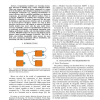Free Online Productivity Tools
i2Speak
i2Symbol
i2OCR
iTex2Img
iWeb2Print
iWeb2Shot
i2Type
iPdf2Split
iPdf2Merge
i2Bopomofo
i2Arabic
i2Style
i2Image
i2PDF
iLatex2Rtf
Sci2ools
AEI
2010
2010
BRAHMS: Novel middleware for integrated systems computation
Abstract-- Computational modellers are becoming increasingly interested in building large, eclectic, biological models. These may integrate nervous system components at various levels of description, other biological components (e.g. muscles), non-biological components (e.g. statistical discriminators or control software) and, in embodied modelling, even hardware components, all potentially with different authors. There is a need for middleware to facilitate these integrated systems. BRAHMS, a Modular Execution Framework, fills that need by defining a supervisor-process interface and an (extensible) set of process-process interfaces; authors can write to these interfaces, and processes will integrate as required. Additional benefits include reuse (never code the same model twice), cross-user readability, system-level parallelisation on multi-core or multi-node environments, cross-language integration, data logging, performance analysis, and run-stop-examine-continue execution. BRAHMS e...
| Added | 08 Dec 2010 |
| Updated | 08 Dec 2010 |
| Type | Journal |
| Year | 2010 |
| Where | AEI |
| Authors | Benjamin Mitchinson, Tak-Shing Chan, Jonathan M. Chambers, Martin J. Pearson, Mark D. Humphries, Charles W. Fox, Kevin N. Gurney, Tony J. Prescott |
Comments (0)

